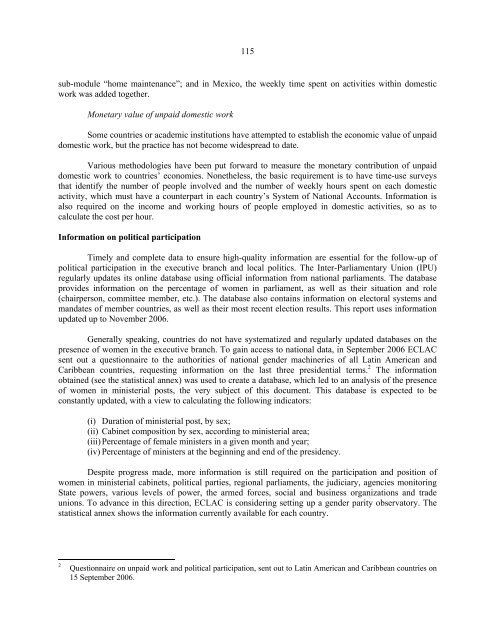Women in Latin America and the Caribbean - Cepal
Women in Latin America and the Caribbean - Cepal
Women in Latin America and the Caribbean - Cepal
You also want an ePaper? Increase the reach of your titles
YUMPU automatically turns print PDFs into web optimized ePapers that Google loves.
115<br />
sub-module “home ma<strong>in</strong>tenance”; <strong>and</strong> <strong>in</strong> Mexico, <strong>the</strong> weekly time spent on activities with<strong>in</strong> domestic<br />
work was added toge<strong>the</strong>r.<br />
Monetary value of unpaid domestic work<br />
Some countries or academic <strong>in</strong>stitutions have attempted to establish <strong>the</strong> economic value of unpaid<br />
domestic work, but <strong>the</strong> practice has not become widespread to date.<br />
Various methodologies have been put forward to measure <strong>the</strong> monetary contribution of unpaid<br />
domestic work to countries’ economies. None<strong>the</strong>less, <strong>the</strong> basic requirement is to have time-use surveys<br />
that identify <strong>the</strong> number of people <strong>in</strong>volved <strong>and</strong> <strong>the</strong> number of weekly hours spent on each domestic<br />
activity, which must have a counterpart <strong>in</strong> each country’s System of National Accounts. Information is<br />
also required on <strong>the</strong> <strong>in</strong>come <strong>and</strong> work<strong>in</strong>g hours of people employed <strong>in</strong> domestic activities, so as to<br />
calculate <strong>the</strong> cost per hour.<br />
Information on political participation<br />
Timely <strong>and</strong> complete data to ensure high-quality <strong>in</strong>formation are essential for <strong>the</strong> follow-up of<br />
political participation <strong>in</strong> <strong>the</strong> executive branch <strong>and</strong> local politics. The Inter-Parliamentary Union (IPU)<br />
regularly updates its onl<strong>in</strong>e database us<strong>in</strong>g official <strong>in</strong>formation from national parliaments. The database<br />
provides <strong>in</strong>formation on <strong>the</strong> percentage of women <strong>in</strong> parliament, as well as <strong>the</strong>ir situation <strong>and</strong> role<br />
(chairperson, committee member, etc.). The database also conta<strong>in</strong>s <strong>in</strong>formation on electoral systems <strong>and</strong><br />
m<strong>and</strong>ates of member countries, as well as <strong>the</strong>ir most recent election results. This report uses <strong>in</strong>formation<br />
updated up to November 2006.<br />
Generally speak<strong>in</strong>g, countries do not have systematized <strong>and</strong> regularly updated databases on <strong>the</strong><br />
presence of women <strong>in</strong> <strong>the</strong> executive branch. To ga<strong>in</strong> access to national data, <strong>in</strong> September 2006 ECLAC<br />
sent out a questionnaire to <strong>the</strong> authorities of national gender mach<strong>in</strong>eries of all Lat<strong>in</strong> <strong>America</strong>n <strong>and</strong><br />
<strong>Caribbean</strong> countries, request<strong>in</strong>g <strong>in</strong>formation on <strong>the</strong> last three presidential terms. 2 The <strong>in</strong>formation<br />
obta<strong>in</strong>ed (see <strong>the</strong> statistical annex) was used to create a database, which led to an analysis of <strong>the</strong> presence<br />
of women <strong>in</strong> m<strong>in</strong>isterial posts, <strong>the</strong> very subject of this document. This database is expected to be<br />
constantly updated, with a view to calculat<strong>in</strong>g <strong>the</strong> follow<strong>in</strong>g <strong>in</strong>dicators:<br />
(i) Duration of m<strong>in</strong>isterial post, by sex;<br />
(ii) Cab<strong>in</strong>et composition by sex, accord<strong>in</strong>g to m<strong>in</strong>isterial area;<br />
(iii) Percentage of female m<strong>in</strong>isters <strong>in</strong> a given month <strong>and</strong> year;<br />
(iv) Percentage of m<strong>in</strong>isters at <strong>the</strong> beg<strong>in</strong>n<strong>in</strong>g <strong>and</strong> end of <strong>the</strong> presidency.<br />
Despite progress made, more <strong>in</strong>formation is still required on <strong>the</strong> participation <strong>and</strong> position of<br />
women <strong>in</strong> m<strong>in</strong>isterial cab<strong>in</strong>ets, political parties, regional parliaments, <strong>the</strong> judiciary, agencies monitor<strong>in</strong>g<br />
State powers, various levels of power, <strong>the</strong> armed forces, social <strong>and</strong> bus<strong>in</strong>ess organizations <strong>and</strong> trade<br />
unions. To advance <strong>in</strong> this direction, ECLAC is consider<strong>in</strong>g sett<strong>in</strong>g up a gender parity observatory. The<br />
statistical annex shows <strong>the</strong> <strong>in</strong>formation currently available for each country.<br />
2<br />
Questionnaire on unpaid work <strong>and</strong> political participation, sent out to Lat<strong>in</strong> <strong>America</strong>n <strong>and</strong> <strong>Caribbean</strong> countries on<br />
15 September 2006.











